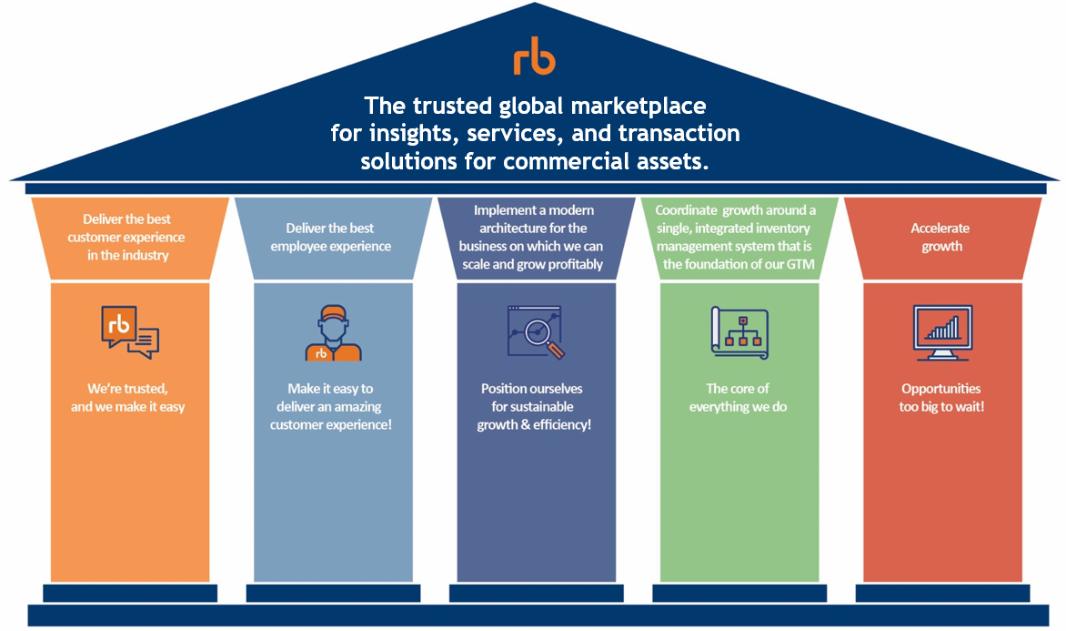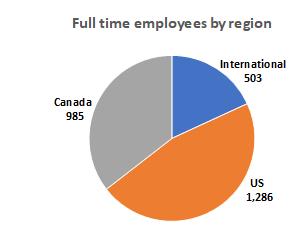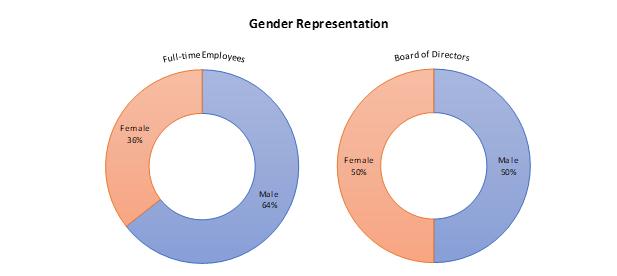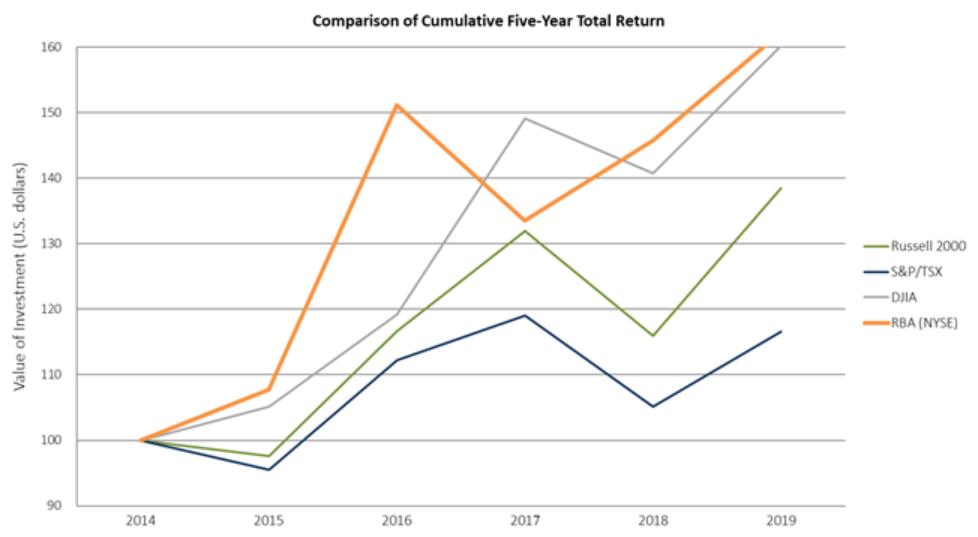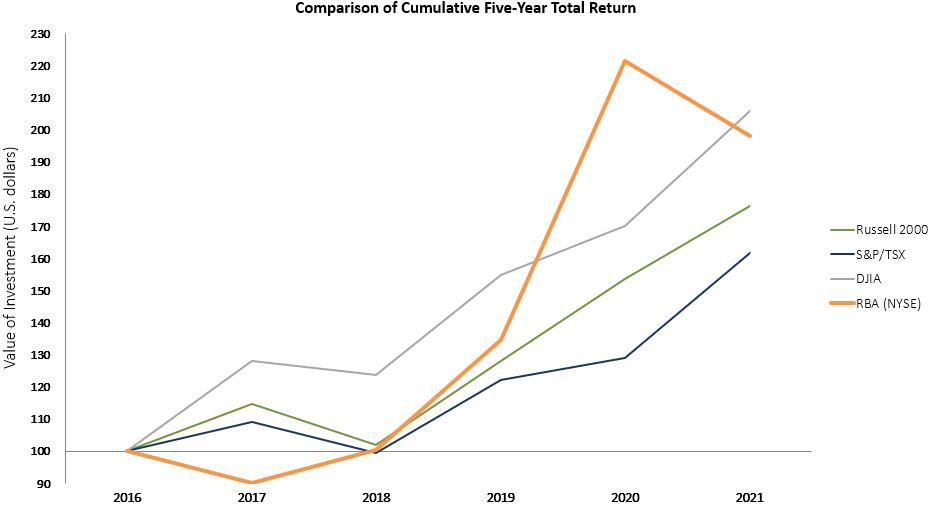Notes to the Consolidated Financial Statements
| Notes to the Consolidated Financial Statements (Tabular amounts expressed in thousands of United States dollars, except where noted) 19. Goodwill | | | | Balance, December 31, 2019 | | $ | 672,310 | Additions | | | 165,770 | Foreign exchange movement | | | 2,530 | Balance, December 31, 2020 | | $ | 840,610 | Additions | | | 108,778 | Foreign exchange movement | | | (1,673) | Balance, December 31, 2021 | | $ | 947,715 |
In 2021, the Company recognized $110,580,000 of goodwill from the acquisition of SmartEquip as well as a reduction in goodwill of $1,802,000 as a result of finalizing the Rouse acquisition purchase price allocation. In 2020, goodwill increased by $165,770,062 from the acquisition of Rouse. 20. Trade and other liabilities | | | | | | | As at December 31, | | 2021 | | 2020 | Trade payables | | $ | 85,743 | | $ | 75,503 | Accrued liabilities | | | 116,647 | | | 99,559 | Social security and sales taxes payable | | | 41,608 | | | 39,909 | Net consumption taxes payable | | | 11,360 | | | 10,434 | Share unit liabilities | | | 10,056 | | | 9,602 | Other payables | | | 12,889 | | | 8,779 | Derivative financial liability | | | 2,005 | | | — | | | $ | 280,308 | | $ | 243,786 |
| | (Tabular amounts expressed in thousands of United States dollars, except where noted)Ritchie Bros.
| 108
|
Table of Contents Notes to the Consolidated Financial Statements (Tabular amounts expressed in thousands of United States dollars, except where noted) 21. Debt | | | | | | | | | | | | | | | Carrying amount | | Carrying amount | | | December 31, | | December 31, | | December 31, | | December 31, | | | 2019 | | 2018 | | 2021 | | 2020 | Short-term debt | | $ | 4,705 | | $ | 19,896 | | $ | 6,147 | | $ | 29,145 | | | | | | | | | | | | | | Long-term debt: | | | | | | | | | | | | | | | | | | | | | | | | | | Term loans: | | | | | | | | Denominated in Canadian dollars, secured, bearing interest at a weighted average rate of 3.958%, due in monthly installments of interest only and quarterly installments of principal, maturing in October 2021 | | | 155,355 | | | 161,891 | | Denominated in United States dollars, secured, bearing interest at a weighted average rate of 3.715%, due in weekly installments of interest only and quarterly installments of principal, repaid in full in December 2019 | | | — | | | 62,690 | | Term loan and long-term revolver loans: | | | | | | | | Term loan denominated in Canadian dollars, secured, bearing interest at a weighted average rate of 2.61%, due in monthly installments of interest only, maturing in September 2026 | | | | 93,283 | | | 98,420 | Long-term revolver loan denominated in Canadian dollars, secured, bearing interest at a weighted average rate of 2.61%, due in monthly installments of interest only, maturing in September 2026 | | | | 46,206 | | | 46,184 | Long-term revolver loan denominated in Canadian dollars, secured, bearing interest at a weighted average rate of 2.25%, due in monthly installments of interest only, maturing in September 2026 | | | | 56,492 | | | — | Long-term revolver loan denominated in U.S. dollars, secured, bearing interest at a weighted average rate of 1.82%, due in monthly installments of interest only, maturing in September 2026 | | | | 117,000 | | | — | Less: unamortized debt issue costs | | | (807) | | | (2,419) | | | (463) | | | (690) | | | | | | | | | Senior unsecured notes: | | | | | | | | | | | | | Bearing interest at 5.375% due in semi-annual installments, with the full amount of principal due in January 2025 | | | 500,000 | | | 500,000 | | Bearing interest at 5.375% due in semi-annual installments, with the full amount of principal due in January 2025 (the "2016 Notes") | | | | 500,000 | | | 500,000 | Less: unamortized debt issue costs | | | | (5,469) | | | (7,266) | Bearing interest at 4.75% due in semi-annual installments, with the full amount of principal due in December 2031 (the "2021 USD Notes") | | | | 600,000 | | | — | Less: unamortized debt issue costs | | | | (1,948) | | | — | Bearing interest at 4.95% due in semi-annual installments, with the full amount of principal due in December 2029 (the "2021 CAD Notes") | | | | 333,464 | | | — | Less: unamortized debt issue costs | | | (9,067) | | | (10,864) | | | (1,127) | | | — | Total long-term debt | | | 645,481 | | | 711,298 | | | 1,737,438 | | | 636,648 | | | | | | | | | | | | | | Total debt | | $ | 650,186 | | $ | 731,194 | | $ | 1,743,585 | | $ | 665,793 | | | | | | | | | | | | | | Long-term debt: | | | | | | | | | | | | | Current portion | | $ | 18,277 | | $ | 13,126 | | $ | 3,498 | | $ | 10,360 | Non-current portion | | | 627,204 | | | 698,172 | | | 1,733,940 | | | 626,288 | Total long-term debt | | $ | 645,481 | | $ | 711,298 | | $ | 1,737,438 | | $ | 636,648 |
Short-term debt Short-term debt is comprised of drawings in different currencies on the Company’s committed revolving credit facilities and has a weighted average interest rate of 1.8% (December 31, 2020: 2.3%). Long-term debt | a) | Term loan and long-term revolver loans |
On October 27, 2016,August 14, 2020, the Company entered into a credit agreement (the “Creditan amendment of the Credit Agreement dated October 27, 2016 (“Credit Agreement”), with a syndicate of lenders. At that time, the Credit Agreement provided the Company with:lenders, totaling $630,000,000 comprised of:
● | (1) | Multicurrency revolving facilities of up to $675,000,000$530,000,000 (the “Revolving facilities”Facilities”); and |
● | (2) | A delayed drawdelayed-draw term loan facility of up to $325,000,000$100,000,000 (the “Term loans”“DDTL Facility” and together with the Revolving Facilities, the “Facilities”);. |
● | At the Company’s election and subject to certain conditions, including receipt of related commitments, incremental term loan facilities and/or increases to the Revolving facilities in an aggregate amount of up to $50,000,000. |
The Company may use the proceeds from the Revolving facilities for general corporate purposes. The amount available pursuant to the Terms loans was only available to finance the acquisition of IronPlanet and is not available for other corporate purposes upon repayment of amounts borrowed under that facility. On May 31, 2017, the Company borrowed $325,000,000 under the Term loans to finance the acquisition of IronPlanet (note 29). The Term loans amortize in equal quarterly installments in an annual amount of 5% for the first two years and 10% in the third through fifth years, with the balance payable at maturity. Prepayments are applied against future scheduled mandatory payments. Upon the closing of the acquisition the Credit Agreement became secured by the assets of the Company and certain of its subsidiaries in Canada and the United States. The Credit Agreement may become unsecured again, subject to the Company meeting specified credit rating or leverage ratio conditions.
On June 21, 2018, the Company reduced the amount available on the Company’s Revolving facilities by $185,000,000.
At December 31, 2019, the Company’s Credit Agreement provides the Company with:
● | Revolving facilities of up to $490,000,000 |
● | Terms loans used to finance the acquisition of IronPlanet and |
● | At the Company’s election and subject to certain conditions, including receipt of related commitments, incremental Term loan facilities and/or increases to the Revolving facilities in an aggregate amount of up to $50,000,000. |
Table of Contents Notes to the Consolidated Financial Statements |
| (Tabular amounts expressed in thousands of United States dollars, except where noted) |
|
21. Debt (continued) | a) | Term loan and long-term revolver loans (continued) |
On September 21, 2021, the Company entered into another amendment of its Credit Agreement (“September 2021 Amendment”). The September 2021 Amendment, among other things, (i) extended the maturity date of the Facilities from October 27, 2023 to September 21, 2026, (ii) increased the total size of the Facilities provided under the Credit Agreement to up to $1,045,000,000, including $295,000,000 of commitments under the DDTL Facility, (iii) reduced the applicable margin for base rate loans and LIBOR loans at each pricing tier level, (iv) reduced the applicable percentage per annum used to calculate the commitment fee in respect of the unused commitments under the Revolving Facilities at each pricing tier level, and (v) included customary provisions to provide for the eventual replacement of LIBOR as a benchmark interest rate. Immediately prior to the September 2021 Amendment, the aggregate principal amount outstanding under the DDTL Facility was $90,000,000 ($118,889,995 Canadian dollars). In connection with the September 2021 Amendment, the Company refinanced that amount with the proceeds from a borrowing under the DDTL Facility. There are no mandatory principal repayments of borrowings under the DDTL Facility until the earlier of when the remaining $205,000,000 is drawn or Q3 2022. Once principal payments become mandatory, they are subject to an annual amortization rate of 5%, payable in quarterly installments, with the balance payable at maturity. The Company incurred total debt issuance costs of $4,262,000 in connection with the September 2021 Amendment. At December 31, 2021, the Company had unamortized deferred debt issue costs relating to the Credit Agreement of $5,699,000. For the year ended December 31, 2019,2021, the Company made scheduled debtterm loan repayments of $13,592,000 on the Term loans (2018: $11,013,000)$5,328,000 (2020: $13,711,000). ForThe Company did 0t make any voluntary term loan prepayments during the year ended December 31, 2019, the Company made voluntary prepayments totalling $62,690,000 (2018: $80,000,000) on the term loan denominated in United States dollars.2021 (2020: $nil). 2016 Notes On December 21, 2016, the Company completed the offering of $500,000,000 aggregate principal amount of 5.375% senior unsecured notes due January 15, 2025 (the “Notes”“2016 Notes”). Interest on the 2016 Notes is payable semi-annually. The 2016 Notes are jointly and severally guaranteed on an unsecured basis, subject to certain exceptions, by eachcertain of the Company’s subsidiaries that is a borrower or guarantees indebtedness under the Credit Agreement.subsidiaries. IronPlanet, Rouse, and certain of itstheir respective subsidiaries were added as additional guarantors in connection with the acquisitionacquisitions of IronPlanet.IronPlanet and Rouse, respectively. Short-term debt is comprised of drawings in different currencies on the Company’s committed revolving credit facilities and have a weighted average interest rate of 2.3% (December 31, 2018: 2.3%).
As at December 31, 2019, principal repayments for the remaining period to the contractual maturity dates are as follows:
| | | | | | Face value | 2020 | | $ | 18,277 | 2021 | | | 137,078 | 2022 | | | — | 2023 | | | — | 2024 | | | — | Thereafter | | | 500,000 | | | $ | 655,355 |
As at December 31, 2019, the Company had unused committed revolving credit facilities aggregating $489,937,000 of which $485,509,000 is available until October 27, 2021.
22. Other non-current liabilities2021 Notes
| | | | | | | As at December 31, | | 2019 | | 2018 | Operating lease liability | | $ | 111,322 | | $ | — | Tax payable | | | 20,232 | | | 22,583 | Finance lease liability | | | 16,336 | | | 10,146 | Other | | | 3,348 | | | 9,251 | | | $ | 151,238 | | $ | 41,980 |
On December 21, 2021, the Company completed the offering of two series of senior notes: (i) $600,000,000 aggregate principal amount of 4.750% senior notes due December 15, 2031 (the “2021 USD Notes”) and (ii) $425,000,000 Canadian dollar aggregate principal amount of 4.950% due December 15, 2029 ( the “2021 CAD Notes”, and together with the 2021 USD Notes, the “2021 Notes”).
23. EquityThe gross proceeds from the offering together with certain additional amounts including prepaid interest were placed into escrow accounts and dividends
Share capital
Preferred stock
Unlimited numberwill be held in escrow until the completion of senior preferred shares, without par value, issuablethe Euro Auctions Acquisition. The 2021 Notes are recorded on the consolidated balance sheet in series.
Unlimited numbernon-current restricted cash and included in long term debt. If the Euro Auctions Acquisition is not consummated on or before September 30, 2022 or the SPA is terminated prior to such date, the Company will redeem all of junior preferred shares, without par value, issuable in series.
All issued shares are fully paid. NaN preferred shares have been issued.
23. Equitythe original offering price of the 2021 Notes, plus accrued and dividends(continued)
Share capital (continued)
Share repurchase
There were 1,223,674 common shares repurchased for $42,012,000 duringunpaid interest. Once out of escrow, interest on the year ended December 31, 2019. There were 0 common shares repurchased in the years ended December 2018 and 2017.
Dividends
Declared and paid2021 Notes is payable semi-annually.
The Company declared and paid the following dividends during the years ended December 31, 2019, 2018, and 2017:
| | | | | | | | | | | | | | | | | Dividend | | | | Total | | | | | Declaration date | | per share | | Record date | | dividends | | Payment date | Year ended December 31, 2019: | | | | | | | | | | | | | Fourth quarter 2018 | | January 25, 2019 | | $ | 0.1800 | | February 15, 2019 | | $ | 19,568 | | March 8, 2019 | First quarter of 2019 | | May 8, 2019 | | | 0.1800 | | May 29, 2019 | | | 19,592 | | June 19, 2019 | Second quarter of 2019 | | August 8, 2019 | | | 0.2000 | | August 28, 2019 | | | 21,631 | | September 18, 2019 | Third quarter 2019 | | November 7, 2019 | | | 0.2000 | | November 27, 2019 | | | 21,744 | | December 18, 2019 | | | | | | | | | | | | | | Year ended December 31, 2018: | | | | | | | | | | | | | Fourth quarter 2017 | | January 26, 2018 | | $ | 0.1700 | | February 16, 2018 | | $ | 18,246 | | March 9, 2018 | First quarter of 2018 | | May 9, 2018 | | | 0.1700 | | May 30, 2018 | | | 18,342 | | June 20, 2018 | Second quarter of 2018 | | August 7, 2018 | | | 0.1800 | | August 29, 2018 | | | 19,528 | | September 19, 2018 | Third quarter 2018 | | November 8, 2018 | | | 0.1800 | | November 28, 2018 | | | 19,562 | | December 19, 2018 | | | | | | | | | | | | | | Year ended December 31, 2017: | | | | | | | | | | | | | Fourth quarter 2016 | | January 23, 2017 | | $ | 0.1700 | | February 10, 2017 | | $ | 18,160 | | March 3, 2017 | First quarter 2017 | | May 4, 2017 | | | 0.1700 | | May 23, 2017 | | | 18,188 | | June 13, 2017 | Second quarter 2017 | | August 4, 2017 | | | 0.1700 | | August 25, 2017 | | | 18,210 | | September 15, 2017 | Third quarter 2017 | | November 7, 2017 | | | 0.1700 | | November 29, 2017 | | | 18,227 | | December 20, 2017 |
Declared and undistributed
In addition to the above dividends, since the end of the year the Directors have recommended the payment of a final dividend of $0.20 cents per common share, accumulating to a total dividend of $21,906,000. The aggregate amount of the proposed final dividend is expected to be paid out of retained earnings on March 6, 2020 to stockholders of record on February 14, 2020. This dividend payable has not been recognized as a liability in the financial statements. The payment of this dividend will not have any tax consequence for the Company.
Foreign currency translation reserve
Foreign currency translation adjustment includes intra-entity foreign currency transactions that are of a long-term investment nature, which generated net loss of $1,082,000 for 2019 (2018: net loss of $9,602,000; 2017: net gain of $18,129,000).
Table of Contents Notes to the Consolidated Financial Statements (Tabular amounts expressed in thousands of United States dollars, except where noted) | b) | Senior unsecured notes (continued) |
The Company intends to use the net proceeds from the offering of the 2021 Notes, together with proceeds from its DDTL Facility, to fund the consideration payable of the Euro Auctions Acquisition and any related fees and expenses. Until completion of the Euro Auctions Acquisition, the 2021 Notes are secured only by the amounts deposited into certain escrow accounts established in connection with the issuance of the 2021 Notes. Upon consummation of the proposed Euro Auctions Acquisition, the 2021 Notes will be, jointly and severally, fully and unconditionally guaranteed, on a senior unsecured basis, by the Company and each of the Company’s subsidiaries that is a borrower, or guarantees indebtedness, under the Company’s Credit Agreement and its 2016 Notes. Euro Auctions, and its respective subsidiaries that become a borrower or guarantor under the Credit Agreement are expected to become guarantors following the consummation of the Euro Auctions Acquisition. The Company has incurred total debt issue costs of $1,954,000 in connection with the offering of the 2021 USD Notes, and $1,129,000 in connection with the offering of the 2021 CAD Notes. Additionally, fees of approximately $10,000,000 will be paid to Goldman Sachs Bank USA Bank and certain other financial institutions when the proceeds are released from escrow to finance the Euro Auctions Acquisition. These fees will be capitalized as debt issuance costs and amortized over the term of the respective senior notes.
As at December 31, 2021, principal repayments for the remaining period to the contractual maturity for our long term debt are as follows: | | | | | | Face value | 2022 | | $ | 3,498 | 2023 | | | 4,664 | 2024 | | | 4,664 | 2025 | | | 504,664 | 2026 | | | 295,492 | Thereafter | | | 933,464 | | | $ | 1,746,446 |
As at December 31, 2021, the Company had unused committed revolving credit facilities aggregating $515,581,000 that are available until September 2026 subject to certain covenant restrictions, unused uncommitted revolving credit facilities aggregating $5,000,000 that are available until October 2023, and unused uncommitted revolving credit facilities aggregating $5,000,000 with no maturity date.The Company was in compliance with all financial and other covenants applicable to the credit facilities at December 31, 2021. 22. Other non-current liabilities | | | | | | | | | December 31, | | December 31, | | | 2021 | | 2020 | Operating lease liability | | $ | 109,882 | | $ | 112,818 | Tax payable | | | 18,859 | | | 19,706 | Finance lease liability | | | 13,983 | | | 17,109 | Other | | | 4,536 | | | 3,367 | | | $ | 147,260 | | $ | 153,000 |
|
|


